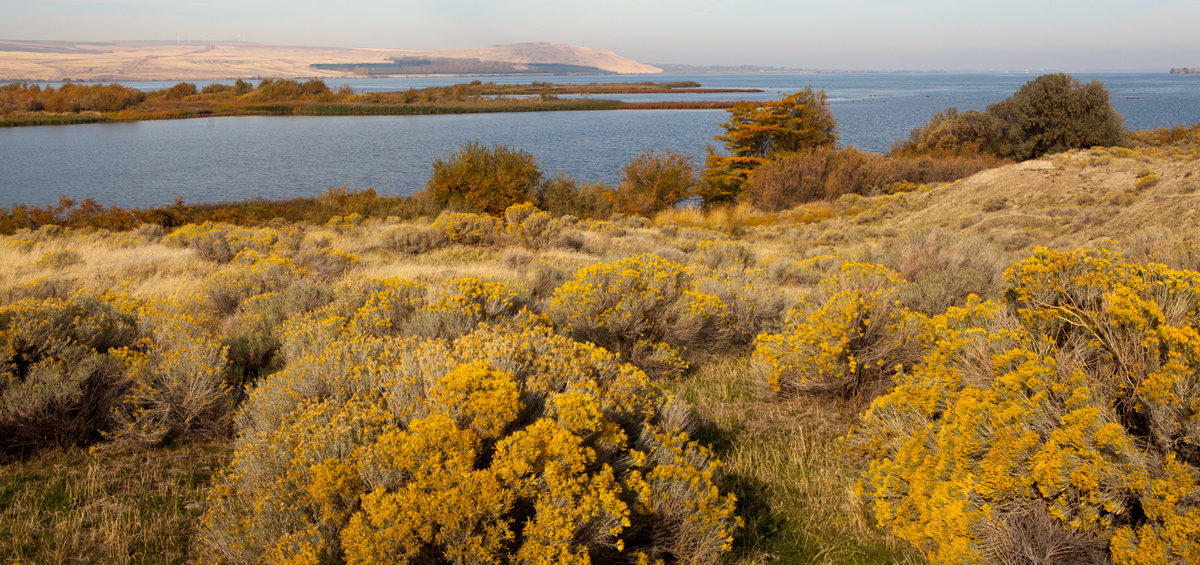The captains council with the Wanapums and Yakamas and record Sahaptian vocabularies. Clark measures the widths of the Snake and Columbia rivers, and they purchase 40 dogs as a store of provisions. Late in the day, the expedition heads down the Columbia and camps below the Twin Sisters in Wallula Gap.
Great Columbia River
by Yellowstone Public Radio[1]Originally aired weekdays by Yellowstone Public Radio during the Bicentennial observance of 2003-2006. Narrated by Hal Hansen. Scripts by Whit Hansen and Ed Jacobson. Produced by Leni Holliman. © … Continue reading
Columbia River
© 19 October 2013 by Kristopher K. Townsend. Permission to use granted under the Creative Commons Attribution-Share Alike 4.0 International license.
Above: This view is northwest looking up the Columbia River. The mouth of the Walla Walla is to the left, but not shown in the photograph.
A Cold Morning
a cold morning faire & wind from S E Several Heath hens or large Pheasents [Sage Grouse] lit near us & the men killed Six of them.
—William Clark
A Morning Council
Several canoes of Indians Came down and joined those with us, we had a council with those in which we informed of our friendly intentions towards them and all other of our red children; of our wish to make a piece between all of our red Children in this quarter &c. &c. this was conveyed by Signs thro: our 2 Chiefs who accompanied us, and was understood, we made a 2d Chief and gave Strings of wompom to them all in remembrance of what we Said—
—William Clark
Sahaptian Vocabularies
In the forenoon our Commanding Officers were employed in getting specimens of the language of the natives, there being three, or part of three, different nations here.
—Patrick Gass
Measuring River Widths
Capt. Clark measured Columbian River and the Ki mo e nem Rivers and found the Columbia River to be 860 yards wide, and the ki moo e nem R. to be 475 yards wide at the forks. Capt. Lewis Compleated his observations
—John Ordway
Trading for Food
We thought it necessary to lay in a Store of Provisions for our voyage, and the fish being out of Season, we purchased forty dogs for which we gave articles of little value, Such as bells, thimbles, knitting pins, brass wire & a few beeds all of which they appeared well Satisfied and pleased.
—William Clark
Wallula Gap
the Countrey rises here about 200 feet above The water and is bordered wth black rugid rocks, at the Commencement of this high Countrey on Lard Side a Small riverlet falls in which appears to passed under the high County in its whole cose Saw a mountain bearing S. W. conocal form Covered with Snow.
—William Clark
Weather Diary
Day of the month Wind State of the Weather 18th S E fair Note from the 18th to the 22d of octr. descending the Great Columbia to the falls [Celilo Falls].
—William Clark[2]Some abbreviations have been spelled out.
Experience the Lewis and Clark Trail
The Lewis and Clark Trail Experience—our sister site at lewisandclark.travel—connects the world to people and places on the Lewis and Clark Trail.
Plan a trip related to October 18, 1805:

Snake River Confluence is a High Potential Historic Site along the Lewis and Clark National Historic Trail managed by the U.S. National Park Service. The site includes Sacajawea State Park with interpretation and a visitor’s center.
Walla Walla River Confluence is a High Potential Historic Site along the Lewis and Clark National Historic Trail managed by the U.S. National Park Service. The confluence is best visited by boat, Madame Dorian memorial Park, and McNary National Wildlife Refuge.
Notes
| ↑1 | Originally aired weekdays by Yellowstone Public Radio during the Bicentennial observance of 2003-2006. Narrated by Hal Hansen. Scripts by Whit Hansen and Ed Jacobson. Produced by Leni Holliman. © 2003 by Yellowstone Public Radio. |
|---|---|
| ↑2 | Some abbreviations have been spelled out. |





